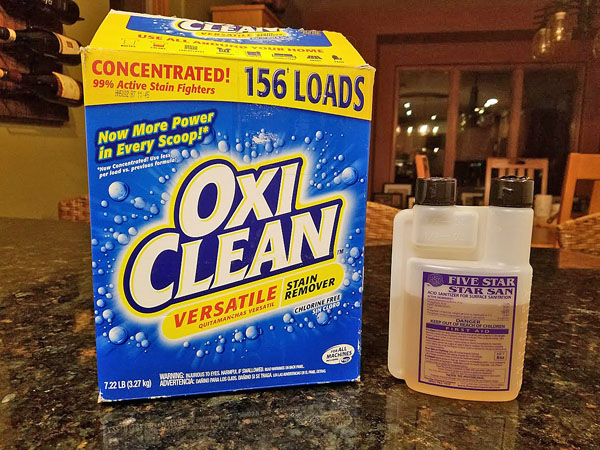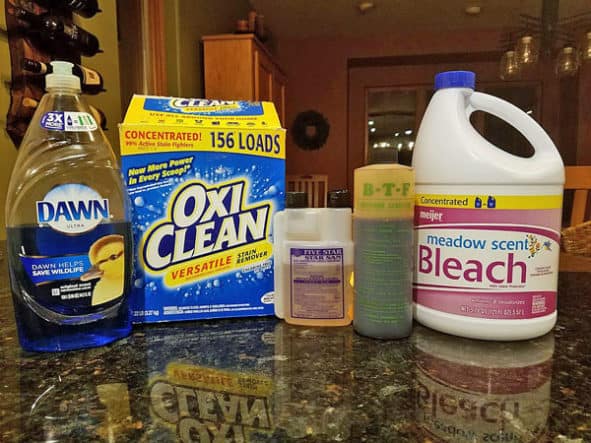Making good home-brewed beer is not that difficult. Making really good home-brewed beer means you have to pay attention to all the finer details throughout the brewing process. One of the basic, and most important, details are cleaning and sanitizing homebrewing equipment.
This is critical whether it’s your first batch or your 100th batch. In this article, I am going to share some of the cleaning and sanitizing tips I’ve learned, along with the mistakes I’ve made, in my 10 plus years of homebrewing. Following these tips will definitely help you make better beer!
In this article, we will be providing you with a few links to some products for pricing and informational purposes. We are required to let you know some of these links are “affiliate links”. This means if you click on a link and make a purchase, we could make a small commission, at no extra cost to you. This helps offset the cost of maintaining our website. Now, let’s get started.
Biggest Mistake
Table of Contents
In my first article on 7 Reasons Why Beer Brewing At Home Is A Good Hobby, I explained why you should try beer brewing and provided some good pointers. But as with many things, there is a little more to it. The worst thing you can do is follow all the brewing steps perfectly, execute the brewing process flawlessly, and then put your wort in an improperly cleaned or sanitized fermentor! Or by gently stirring your yeast in the fermentor with a contaminated spoon. Either of these things could potentially ruin your entire batch of beer. The main concept here is that once you’ve cooled the wort anything that comes in contact with it must be cleaned and sanitized!
Wort is very susceptible to contamination or infection at this stage of the brewing process! After the wort is fermented, the alcohol makes it a little tougher at fighting the “nasties”, but you still cannot put it in a dirty bottle or keg. It can still become contaminated or at the very least develop one of many off flavors. This can affect a few improperly cleaned/sanitized bottles of beer or it could ruin a whole keg of beer. Let’s take a look at what it takes to properly clean and sanitize your equipment.
Difference Between Cleaning And Sanitizing
When I started brewing beer I did tons of reading and research on every step of the brewing process. That included cleaning my brewing equipment. In many of the articles I read, I got some mixed messages about how I should be cleaning and sanitizing. On several occasions, the two terms were being used interchangeably! This is not the case. So let’s start with the basic definition of each and go over some of the methods and solutions that can be used for each.
Cleaning Brewing Equipment
Definition: The definition of cleaning is simply the visible removal of foreign matter from a surface using a cleaning agent. The actual removal can be accomplished in a couple ways.
Washing
It’s just like washing your dinner dishes. You put them in a sink full of warm water and dishwashing detergent and wash them with a cloth until all the visible signs of food are gone. Then you normally rinse each dish or utensil with hot water to remove the dishwashing soap and any floating food particles that may have stuck to them. After that, you set out to air dry or you towel them dry. You can also put them in an automatic dishwasher, add the dishwashing detergent and let the dishwasher do all the work.
For most homebrewing equipment this is a very good description of the “cleaning” process. Simply washing your fermentors, measuring cups, funnels, thermometers, and utensils in a soap solution are all you’ll need. With the exception of the fermentors, due to their size, using an automatic dishwasher works just fine too.
Soaking
There are a few pieces of homebrewing equipment that will need a little extra attention. Items such as hoses, siphons, wort thieves, bottling wands, bottles, bottling bucket spigots, carboys, kegs… way too many to go into for now (more to come in future articles!), all have small openings or are irregularly shaped.
There is no practical way to wash these items, so they are typically soaked in solutions that help dissolve and loosen any foreign matter. After soaking they should be rinsed thoroughly with hot water to flush away the loose material. They should then be set aside to allow the rinse water to drain and to air dry. If necessary, this process should be repeated until all visible signs of material are gone.
Cleaning Products
When it comes to homebrewing there are several effective cleaners for the different brewing equipment. Let’s take a look at some of the options available to you.
Sanitizing Brewing Equipment
Definition – The definition of sanitizing is the removal of microorganisms and pathogens down to an allowable level for public safety. This level is typically more than 99% free of these germs.
Once the wort has cooled it is very susceptible to contaminants. From that point on any piece of brewing equipment that comes in contact with it must be sanitized. Below is a list of the most common equipment you’ll be using to get your wort from the kettle to the bottle or keg.
Sanitizing Rinse
To properly sanitize your bottles and brewing equipment they will need to be soaked, dipped, or sprayed with a properly mixed sanitizing solution. Keep in mind there may be other items. If in doubt, sanitize it! With the sanitizers I will be covering below, this requires the surfaces to be in contact with the sanitizer for only 1 or 2 minutes. Soaking your equipment for longer is okay, but most of the time it is unnecessary. However, if you bought some used bottles or a keg and want the peace of mind, soaking them for an hour will do the trick.
With that said there are concerns with stainless steel kegs, and other equipment, being exposed to some sanitizers. There are sanitizers that can be corrosive and can damage soft metals and stainless steel. If you are using any sanitizers other than what’s listed below, be sure to check for any warnings or cautions and mix them per the manufacturer’s recommendations. Below are the sanitizers that I have used and will share my experiences with you. I still recommend that you follow the manufacturer’s directions for mixing and using them.
Sanitizing Solutions
There are several different types and brands of sanitizers available. Below are the three sanitizers I’ve used and my experience with them.
Bleach
This is a common household product that makes a good sanitizer. When mixed at a ratio of 1 tablespoon of bleach to one gallon of water it’s very effective, yet not too strong. This is one of the products that there is a lot of controversy on whether you should use it on stainless steel or if you need to rinse after sanitizing. Many feel that at this concentration there is not an issue with either. When I initially started brewing bleach is what I used as a sanitizer and I never had any problem. I did not have any stainless steel equipment to sanitize at the time, so that was never an issue. However, I did rinse my bottles and equipment after sanitizing with bleach. Most of the time I could smell the bleach so I did not want to take the change of flavors in my beer.
Iodophor
In an attempt to get away from having to rinse my bottles and equipment, I next tried Iodophor. I had read that when mixed per manufacturer’s instructions you did not need to rinse. At first, it worked okay, but I didn’t do my due diligence on the product. When I was using the bleach solution I usually saved a gallon jug of it for sanitizing the smaller items, just before bottling or at the start of my next batch. What I failed to realize is that the iodine in Iodophor is volatile and dissipates over time. This oversight on my part caused me at least to infected batches of beer, which I eventually had to dump. That was an expensive lesson for me! One I can hopefully prevent you from making too.
Another minor issue is with Iodophor being an iodine-based product, it has a very light brown color tint in it. This does not affect its sanitizing effectiveness or the flavor of the beer, it just causes some staining of the plastic fermentors and tubing. Most of the staining can be removed by soaking the items in the Oxiclean clean solution. It’s not a big issue but is something you should be aware of.
StarSan
The next sanitizer I tried, and I am currently using, is StarSan, by Five Star. It is an acid-based sanitizer and is safe to use on all brewing equipment. StarSan combines a couple of the things I was looking for in a sanitizer. It doesn’t require rinsing and it can be reused several times. As long as the PH level is 3 or lower it is safe to use.
Final Thoughts
So, in summary, when it comes to cleaning and sanitizing, my favorite cleaners are good ole dish soap and water, and an OxiClean solution for equipment that requires soaking. And my preferred sanitizer is StarSan.
This combination has worked well for me the last dozen batches, with no problems. Is it the only option? Certainly not? Be sure to read the manufacturer’s directions and mix them properly and you should be fine. Remember there are no shortcuts. Be sure to clean and sanitize all of your equipment! Happy brewing!
If you have any comments or questions, you can leave them in the comments section below or you can email us at [email protected]. FYI, we do not collect or share email addresses. We will only use them to reply to your comments or provide answers to your questions. We are also required to let you know that some of our links are “affiliate links”. This means if you click on a link and make a purchase, we could make a small commission, at no extra cost to you. This helps offset the cost of maintaining our website. So, if you like what you’ve seen, please be sure to give us a “Like” and “Share” on Facebook and Instagram too. Thank you for reading and good luck with all your home projects!

If you have any comments or questions, you can leave them in the comments section below or you can email us at [email protected]. FYI, we do not collect or share email addresses. We will only use them to reply to your comments or provide answers to your questions. We are also required to let you know that some of our links are “affiliate links”. This means if you click on a link and make a purchase, we could make a small commission, at no extra cost to you. This helps offset the cost of maintaining our website. So, if you like what you’ve seen, please be sure to give us a “Like” and “Share” on Facebook and Instagram too. Thank you for reading and good luck with all your home projects!

